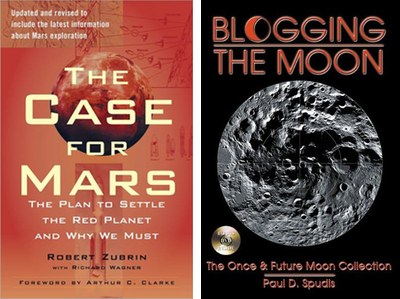Reviews: Revisiting the Moon and Marsby Jeff Foust
|
| “NASA today is no better prepared to send humans to Mars than it was in 1996,” Zubrin writes in the new preface to The Case for Mars. |
The updated edition of The Case for Mars is substantially similar to the original 1996 edition, but updated throughout to take into account developments in the past 15 years. Chapter 2, which discusses past studies of Mars, is updated to discuss the flotilla of robotic missions that have flown to Mars since book’s original publication. Other chapters take into account technology and policy developments, or feature subtler tweaks. For example, Chapter 1 includes a notional chronology of future missions to Mars under the Mars Direct architecture, starting in August 2020; in the original edition, that schedule started in August 2005. The updated edition also includes a “special addendum” about the debate on whether ALH84001 does contain evidence of past Martian life, as well as new appendices with the founding declaration of The Mars Society and a partial list of op-eds that Zubrin has written on Mars and other topics (including his support for servicing the Hubble Space Telescope). One recent development that didn’t make it into the book is Zubrin’s proposal for using Falcon Heavy rockets and Dragon capsules from SpaceX for a minimal human Mars missions (see “A transorbital railroad to Mars”, The Space Review, May 23, 2011), although the book does retain the discussion of the “Mars Semi-Direct” concept, upon which the Falcon Heavy/Dragon concept is based, from the original version.
For those who read the original book, there is probably not enough new content to warrant reading it again, save for those who want to collect the new edition and/or compare it to the original edition. The central arguments regarding how and why humans should go to Mars, and stay, remain intact in the new edition, as well as Zubrin’s clarion call for action in the revised edition’s preface: “The human exploration of Mars is not a task for some future generation. It is a task for ours.”
While Zubrin has become the leading advocate for human Mars exploration, there is no directly analogous person advocating human lunar exploration, no one writing The Case for the Moon. One leading proponent of human exploration of the Moon, though, is planetary scientist Paul Spudis. Since late 2008 Spudis had been authoring a blog, “The Once and Future Moon”, for Air & Space magazine, an effort that grew out of updates Spudis provided from India for the launch of the Chandrayaan-1 lunar orbiter, which included an instrument for which he was the principal investigator. That blog now covers a variety of issues, including lunar science, space policy, and broader issues of exploration and utilization.
| Advocacy for a particular space exploration viewpoint doesn’t end with the publication of a book, but only begins. |
Blogging the Moon republishes many of Spudis’s posts from the blog, from its origins chronicling the Chandrayaan-1 launch through mid-2010. The blog posts are presented largely as they appeared on the site, and in chronological order; links are preserved as footnotes to each post and the comments to each post are also included. This time period, of course, provides rich fodder for discussion, as it spans both major scientific advances, such as new evidence for water ice on the Moon, as well as policy developments like the Augustine Committee and the administration’s decision to cancel Constellation and defer a human return to the Moon.
While Spudis’s blog posts make for interesting, often thought-provoking essays, one leaves Blogging the Moon wishing for something more than simply reprinting a series of blog posts. For example, the book prints the blog posts in chronological order, which can often mean skipping from policy to science to exploration in short order. Segmenting the posts by topic, for example, would have made it easier to follow the developments in each subject area, as well as skip those that are of less interest to an individual reader. Also, including the comments to each post is of questionable value, and can easily overwhelm Spudis’s original post: while each post typically runs a couple of printed pages, the comments, especially on the later, policy-related topics that engender greater debate, can run ten pages or more (and are printed on a gray background in small, sans serif font, making them even less inviting to read.)
The book does offer one benefit over simply perusing the blog’s archives online: a DVD, like those often included in books published by Apogee. The DVD includes a video of a presentation on lunar science and exploration given by Spudis at the Space Studies Institute’s Space Manufacturing conference last October, as well as a slide show (without captions or narration) featuring Spudis. Whether that’s sufficient incentive to buy the book depends in part on how much you like to read extended text passages in print versus on a computer screen. In the meantime, Spudis continues to blog, discussing science, policy, and exploration, as well as speak about it at conferences (see “New strategies for exploration and settlement”, The Space Review, June 6, 2011). As Zubrin can attest, advocacy for a particular space exploration viewpoint doesn’t end with the publication of a book, but only begins.
